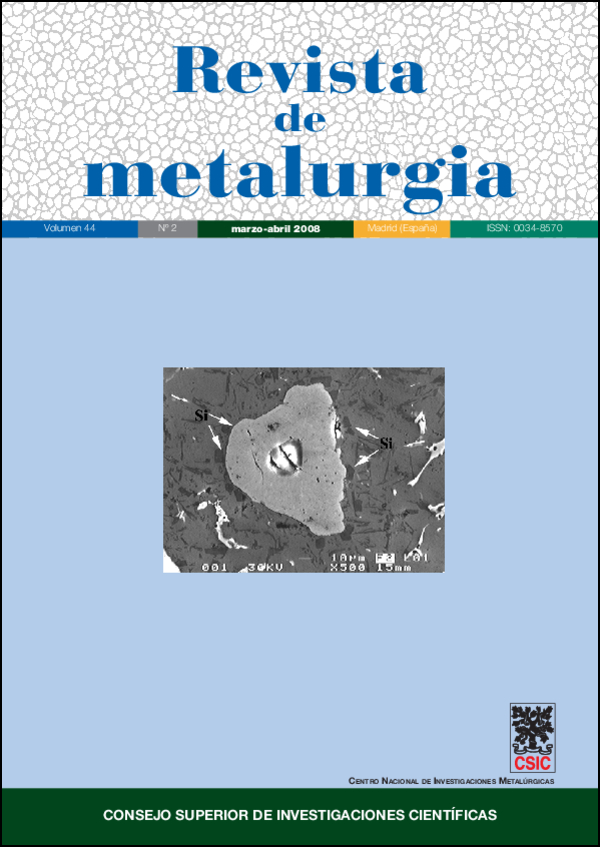Copper electrowinning in a moving-bed cell based on reactive electrodialysis
DOI:
https://doi.org/10.3989/revmetalm.2008.v44.i2.103Keywords:
Electrowinning, Reactive electrodialysis, Reaction engineering, Membranas, Mass transfer, ElectrochemistryAbstract
A two-compartment lab-scale reactive electrodialysis (RED) cell with a moving particulate cathode has been used for copper electrowinning. The cathodic reaction was copper electrodeposition on a bed of copper particles forced to circulate inside a fixed cylindrical enclosure by the action of rotating paddles; the anodic reaction was ferrous to ferric ion oxidation on an anode made of static graphite bars. The anolyte (aqueous FeSO4 + H2SO4) and catholyte (aqueous CuSO4 + H2SO4) are kept separate by an anion membrane which prevents cation transport between the electrolytes. Experiments were carried out in order to characterize cell performance under various conditions. When operating with 40 g/L Cu (II), I = 6 A, T = 50°C, 40 rpm paddle rotation and 990 mL/min electrolyte recirculation flowrate, the specific energy consumption (SEC) for copper electrowinning was 2.25 kWh/kg. An optimization of cell dimensions gave an improved SEC of 1.55 kWh/kg whereas a temperature increase from 50 to 56°C (without changing cell dimensions) produced a SEC of 1.50 kWh/kg, which is 25% lower than normal values for conventional copper electrowinning cells. A comparison was drawn between the performance of this cell and a squirrel-cage cell previously developed by the authors.
Downloads
References
[1] R. Kammel, Hydrometallurgical Process Fundamentals, New York, Plenum Press, Bautista, R. A. (Ed.), 1982, 617-648.
[2] M. Fleischmann And J.W. Oldfield, J. Electroanal. Chem. 29 (1971) 211-230. doi:10.1016/S0022-0728(71)80084-0
[3] M. Fleischmann And J.W. Oldfield, J. Electroanal. Chem. 29 (1971) 231-246. doi:10.1016/S0022-0728(71)80085-2
[4] D. Hutin and F. Coeuret, J. Appl. Electrochem. 7 (1977) 463-471. doi:10.1007/BF00616757
[5] F. Goodridge and C.Vance, J. Electrochim. Acta 24 (1979) 1237-1242. doi:10.1016/0013-4686(79)87078-4
[6] F. Masterson, Metall. Trans. B 13 (1982) 3-13. doi:10.1007/BF02666950
[7] K. Scott, J. Appl. Electrochem. 18 (1988) 504-510. doi:10.1007/BF01022243
[8] V.D. Stankovic and S. Stankovic, J. Appl. Electrochem. 21 (1991) 124-129. doi:10.1007/BF01464292
[9] V. Jiricny, A. Roy and J.W. Evans, Metall. Mater. Trans. B 33 (2002) 677-683. doi:10.1007/s11663-002-0020-7
[10] L. Cifuentes, R. Ortiz And J. M. Casas, Am. Inst. Chem. Eng. J. 51 (2005) 2273-2284.
[11] L. Cifuentes, R. Glasner And J. M. Casas, Chem. Eng. Sci. 59 (2004) 1087-1101. doi:10.1016/j.ces.2003.12.013
[12] L. Cifuentes and R. Glasner, Rev. Metal. Madrid 39 (2003) 260-267.
[13] L. Cifuentes, C. Mondaca and J. M. Casas, Miner. Eng. 17 (2004) 803-809. doi:10.1016/j.mineng.2004.01.010
[14] L. Cifuentes and J. Simpson, Chem. Eng. Sci. 60 (2005) 4915-4923. doi:10.1016/j.ces.2005.04.031
[15] L. Cifuentes and M. Mella, Can. Metall. Q. 45 (2006) 9-16.
[16] L. Cifuentes, M. Mella and G. Crisóstomo, Miner. Eng. 19 (2006), 1385-1387. doi:10.1016/j.mineng.2005.12.005
Downloads
Published
How to Cite
Issue
Section
License
Copyright (c) 2008 Consejo Superior de Investigaciones Científicas (CSIC)

This work is licensed under a Creative Commons Attribution 4.0 International License.
© CSIC. Manuscripts published in both the printed and online versions of this Journal are the property of Consejo Superior de Investigaciones Científicas, and quoting this source is a requirement for any partial or full reproduction.
All contents of this electronic edition, except where otherwise noted, are distributed under a “Creative Commons Attribution 4.0 International” (CC BY 4.0) License. You may read the basic information and the legal text of the license. The indication of the CC BY 4.0 License must be expressly stated in this way when necessary.
Self-archiving in repositories, personal webpages or similar, of any version other than the published by the Editor, is not allowed.
















